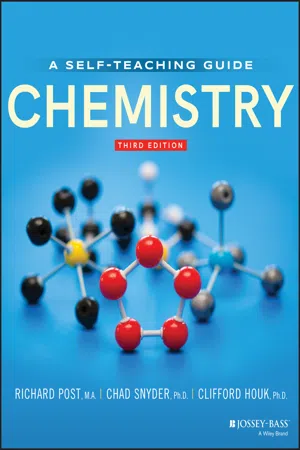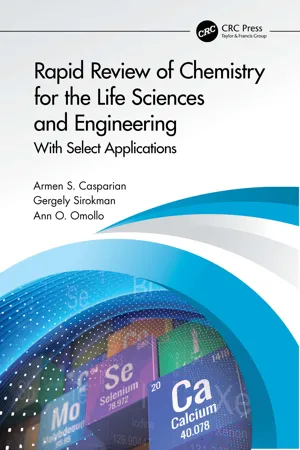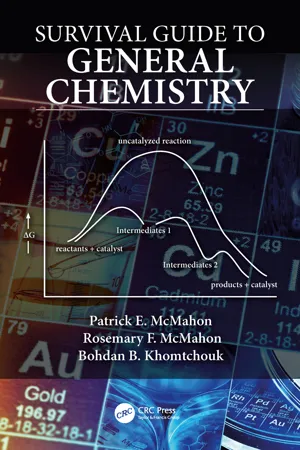Chemistry
Magnitude of Equilibrium Constant
The magnitude of the equilibrium constant in chemistry indicates the extent to which a chemical reaction reaches equilibrium. It is a measure of the ratio of the concentrations of products to reactants at equilibrium. A large magnitude indicates that the reaction favors the formation of products, while a small magnitude indicates that the reaction favors the formation of reactants.
Written by Perlego with AI-assistance
Related key terms
Related key terms
1 of 4
Related key terms
1 of 3
8 Key excerpts on "Magnitude of Equilibrium Constant"
- No longer available |Learn more
- Steven Boone, Drew H. Wolfe(Authors)
- 2011(Publication Date)
- Collins Reference(Publisher)
c . The equilibrium constant equals the product of the molar concentrations of the products, each raised to the power that corresponds to their coefficients in the balanced equation, divided by the product of the molar concentrations of the reactants, each raised to the power corresponding to their coefficients. Equilibria that have reactants and products in more than one phase are heterogeneous equilibria, and those in which all substances in one phase are homogeneous equilibria.If the value of the equilibrium constant is greater than one (K c > 1), the magnitude of the numerator (products) of the equilibrium expression is larger than that of those of the reactants. If the value of K c is less than one (K < 1), the equilibrium concentrations of the reactants are usually greater than those of the products.Equilibrium constants for gas-phase equilibria are often expressed in terms of their partial pressures. This is known as the K p equilibrium constant. The following equation shows the relationship of K p to K c .K p = K c (RT) ΔnEquilibrium constants are obtained by measuring the equilibrium concentrations or partial pressures of each component of an equilibrium mixture and substituting these values into the equilibrium expression.Before a system reaches equilibrium, the concentrations or partial pressures are expressed in terms of the reaction quotient, Q . The expression for Q is in the same form as that of K . The value of Q is used to determine the direction from which an equilibrium develops. Concentration, pressure, volume, and temperature changes affect the concentrations of the components of a chemical equilibrium. Their effects may be predicted by the application of Le Chatelier’s Principle, which states that equilibrium systems tend to absorb any changes that may occur in such a way to reduce the change and return to a state of equilibrium.Test Yourself1. Write the equilibrium expression for the following. - No longer available |Learn more
- Neil D. Jespersen, Pamela Kerrigan(Authors)
- 2023(Publication Date)
- Barrons Educational Services(Publisher)
aq) ions cancel. When reactions are added, the equilibrium constants are multiplied:Determining the Value of the Equilibrium ConstantThe equilibrium constant, K, has a numerical value that may be determined by a variety of methods. The most direct method is to measure the concentration of each reactant and product in the mixture. For example, when sulfur dioxide reacts with oxygen to produce sulfur trioxide, the reaction and equilibrium law may be written as in Equation 9.3 :If the concentrations at equilibrium are determined as [O2 ] = 2.0 × 10− 8 M, [SO2 ] = 3.4 × 10− 9 M, and [SO3 ] = 0.971 M, they can be substituted into the equilibrium law to calculate the value of the equilibrium constant:This method of determining the value of an equilibrium constant requires three measurements, and if Kc is very large or very small, it can lead to considerable experimental error. In addition, it may be impossible to analyze the mixture for all possible components. Other ways to determine the equilibrium constant, based on chemical stoichiometry, are described later in this chapter.Using the Equilibrium ExpressionExtent of Reaction and Thermodynamically Favorable Reactions
The value of the equilibrium constant indicates the extent to which reactants are converted into products in a chemical reaction. If the equilibrium constant is large, it indicates that the amount of products present at equilibrium is much greater than the amount of reactants. A very large equilibrium constant, greater than 1010 , for example, means that for all intents and purposes the reaction goes to completion. Conversely, when K is very small, less than 10− 10 , very little product is formed and virtually no visible reaction occurs. If K - eBook - ePub
Chemistry
Concepts and Problems, A Self-Teaching Guide
- Richard Post, Chad Snyder, Clifford C. Houk(Authors)
- 2020(Publication Date)
- Jossey-Bass(Publisher)
equilibrium constant is the ratio of the concentration of the products divided by the concentration of the reactants at equilibrium and at a specified temperature. The equilibrium constant (product concentrations divided by reactant concentrations) is valid only at a specified temperature after the reaction has gone to (completion, equilibrium) __________Answer: equilibriumBelow is a reversible reaction and the expression for the equilibrium constant for this reversible reaction.The symbol Keqrepresents the equilibrium constant and the brackets [] represent the concentration (usually in moles per liter) of each product and reactant. Look at the placement of each reactant and product in the equilibrium constant expression. In the equilibrium constant expression for a reversible reaction, the (products, reactants) ____________ are located in the numerator or upper part of the fraction and the (products, reactants) ________________ are located in the denominator or lower part of the fraction.Answer: products; reactantsThe standard equation, then, for Keqis as follows.Write the equilibrium constant expression for the following reversible reaction.Keq= ___________________Answer:(Since there are two products, they should be placed in the upper part of the fraction. The one reactant belongs in the lower part of the fraction.) - eBook - ePub
Rapid Review of Chemistry for the Life Sciences and Engineering
With Select Applications
- Armen S. Casparian, Gergely Sirokman, Ann Omollo(Authors)
- 2021(Publication Date)
- CRC Press(Publisher)
4 Chemical EquilibriumDOI: 10.1201/9781003092759-44.1 Basic Concept
Reaction equations describe substances, called reactants, which when put together react and produce other different substances, called products. It may appear as if only products remain after the reaction is finished. In reality, many reactions do not go to completion, even if the reactants are present in stoichiometric ratios or amounts. Rather, they reach a condition known as equilibrium, denoted by double, reversible arrows in the reaction equation. Equilibrium means that there is a balance between the reactant side and the product side, or simply between the reactants and the products, and that the reaction is reversible. The chemistry of many air pollutants falls and many bodily functions under the heading of equilibrium reactions. The equilibrium condition is dynamic, not static, allowing microscopic changes in reactant and product concentrations to take place, such that no net change in reactant or product concentrations occurs, provided that no external stresses are applied. At any given time, all species in the reaction equation—reactants and products—are present at equilibrium in varying amounts. The relationship among these varying amounts can be described by a mathematical formula known as the equilibrium constant expression or simply the equilibrium expression. The equilibrium expression is set equal to an equilibrium constant symbolized by Kc .An equilibrium reaction can be generally represented as follows:a A + b B ⇋ g G + h H(4.1)The Kc expression can then be expressed as follows:(4.2)K c=[ G ]g[ H ]h[ A ]a[ B ]bwhere a, b, g, and h represent the stoichiometric coefficients in the balanced reaction, and the brackets [ ] indicate molar concentrations. The simplest interpretation of Kc is that it is a measure of the extent to which a reaction goes toward completion, i.e., a reaction where the product side is favored. The meaning of Kc - eBook - ePub
- Patrick E. McMahon, Rosemary McMahon, Bohdan Khomtchouk(Authors)
- 2019(Publication Date)
- CRC Press(Publisher)
constant, K (or K (subscript) to indicate a specific type of reaction). One conceptual view of equilibrium is described through the general rate expressions for the forward and reverse reactions (a more exact derivation can be developed using the techniques described in Chapter 24): k (forward) [A] x [B] y = k (reverse) [C] x [D] y ; this equation can be rewritten as: k (forward) k (reverse) = [C] x [D] y [A] x [B] y where k (forward) k (reverse) is related to the equilibrium constant K. An equation that expresses the correct equilibrium concentration ratio equal to the equilibrium constant (either the symbol or its actual numerical value) is termed the equilibrium expression: K (forward reaction) = [C] c [D ] d / [A] a [B] b The equilibrium constant, K, has a specific numerical value determined by the concentrations of each molecule in the balanced equation under specific. conditions. Example: Use the general definitions to write the complete equilibrium expression for the following reversible reaction; the symbol, K, is used since no numerical value is given. CH 4 + 2 Cl 2 → CH 2 Cl 2 + 2 HCl ← K = [C H 2 C l 2 ] [HCl ] 2 [C H 4 ] [C l 2 ] 2 Example: Assume that under certain conditions, the concentrations at equilibrium of each species in the previous equation are: [CH 2 Cl 2 ] = 0.850 M; [HCl] = 0.145 M [CH 4 ] = 0.0522 M; [Cl 2 ] = 0.166 M. Calculate the numerical value of K. K= [CH 2 Cl 2 ] [HCl] 2 [CH 4 ] [Cl 2 ] 2 = (0.850 M) (0.145 M) 2 (0.0522 M) (0.166 M) 2 K = 1 2. 4 The expression for the reverse reaction could be stated as: K (r e v e r s e r e a c t i o n) = [A] a [B ] b [C] c [D ] d The symmetry of the expressions for the forward and reverse reactions shows - Mark Kernion, Joseph A. Mascetta(Authors)
- 2021(Publication Date)
- Barrons Educational Services(Publisher)
eq means that equilibrium occurs almost at once and relatively little product is produced.The equilibrium constant, Keq , has been determined experimentally for many reactions, and the values are printed in chemical handbooks. (See Tables and in the Equations and Tables for Reference section.)Suppose we find the Keq for reacting H2 and I2 at 490°C to be equal to 45.9. Then the equilibrium constant for the reactionH2 + I2 ⇌ 2HI at 490°Cis EXAMPLEThree moles of H2 and 3 mol of I2 are introduced into a 1 L box at a temperature of 490°C. Find the concentration of each substance in the box when equilibrium is established.SOLUTION Initial conditions: The reaction proceeds to equilibrium and At equilibrium, then, and so If then taking the square root of each side givesSolving for x,x = 2.32Substituting this x value into the concentration expressions at equilibrium, we haveThe crucial step in this type of problem is setting up the concentration expressions from your knowledge of the equation. Suppose that this problem had been as follows. Find the concentrations at equilibrium for the same conditions as in the preceding example except that only 2 mol of HI are injected into the box. At equilibrium[HI] = (2 – x) moles/liter(For every mole of HI that decomposes, only 0.5 mol of H2 and 0.5 mol of I2 are formed.)Solving for x givesx = 0.456Then, substituting into the equilibrium conditions,Le Châtelier’s Principle
A general law, Le Châtelier’s Principle- eBook - ePub
Handbook of Biochemistry
Section D Physical Chemical Data, Volume I
- Gerald D Fasman(Author)
- 2018(Publication Date)
- CRC Press(Publisher)
We offer in this report several recommendations with the aim of increasing the usefulness of biochemical equilibrium data and coordinating the results of different investigators. These recommendations include a set of standard conditions which would facilitate the attainment of a common body of knowledge of a wide range of biochemical equilibria. This does not preclude the choice of special experimental conditions that may be appropriate for certain reactions; but whenever possible these reactions should also be studied under the recommended standard conditions. To avoid confusion in interpretation we also recommend standardization of terminology, symbols, and units in the presentation of such data.For other discussions of the presentation of numerical data and of thermodynamic data derived from experiments, we call the attention of the reader to guides prepared by CODATA1 and IUPAC.2PART I. STANDARD CONDITIONS FOR EQUILIBRIUM MEASUREMENTSTrue thermodynamic equilibrium constants are defined in terms of activities of the reactants and products. In many systems of biochemical interest it is not possible to evaluate the activities of all components. It is, therefore, frequently necessary to calculate equilibrium constants in terms of concentrations. The proper quotient of equilibrium concentrations is acceptably constant for many purposes, and will be referred to in this document as the concentration equilibrium constant, with the symbol Kc . However, it should be recognized that values for such equilibrium constants, Kc , and corresponding Gibbs energy changes,Δ, may not be truly constant as the composition of the system is changed.*G c o - eBook - ePub
- Louis Theodore, Francesco Ricci, Timothy Vanvliet(Authors)
- 2011(Publication Date)
- Wiley-AIChE(Publisher)
Most reactions have an opposing (or reverse) reaction. The rates of the forward and reverse reactions determine the equilibrium distribution of the reactants and products. Consider once again the authors’ favorite elementary reversible reaction(13.9)The elementary rate law of the forward reaction for A is(13.10)where k A is the forward reaction velocity constant for the forward reaction. For the reverse reaction(13.11)where k’ A is the reaction velocity constant for the reverse reaction. At equilibrium, the rate of production of A is just equal to the rate of consumption or disappearance of A so that, at equilibrium, the rates of production and consumption are equal, i.e.,(13.12)Combining Equations (13.10) , (13.11) , and (13.12) gives(13.13)or(13.14)The ratio of these rate constants is defined as the chemical reaction equilibrium (CRE) constant K based on concentration, i.e.,(13.15)This equilibrium constant may be measured experimentally, or obtained directly from rate constants. The reader should note that the equilibrium constant above is based on concentrations. It is very specific and is limited in application to some liquid phase reactions.The generally accepted all-purpose equilibrium constant K (also referred to as the true equilibrium constant) can be shown to be related to the previously developed standard free energy of reaction.The following equation is used to calculate the chemical reaction equilibrium constant K at a temperature T :(13.16)The value of this equilibrium constant depends on the temperature at which the equilibrium is established. The effect of temperature on K must now be examined. This is addressed in the next three sections.ILLUSTRATIVE EXAMPLE 13.6Calculate the chemical reaction equilibrium constant K for a reaction that has a ΔG value of -20.0 kcal/gmol at 70°F.SOLUTION :From Equation (13.16)with T = 70°F = 294K.For ΔG 0 = -20.0 kcal/gmolThis low value of K suggests an extremely high conversion of reactants. Details on conversion calculations are provided in the next chapter.
Index pages curate the most relevant extracts from our library of academic textbooks. They’ve been created using an in-house natural language model (NLM), each adding context and meaning to key research topics.
Explore more topic indexes
Explore more topic indexes
1 of 6
Explore more topic indexes
1 of 4







